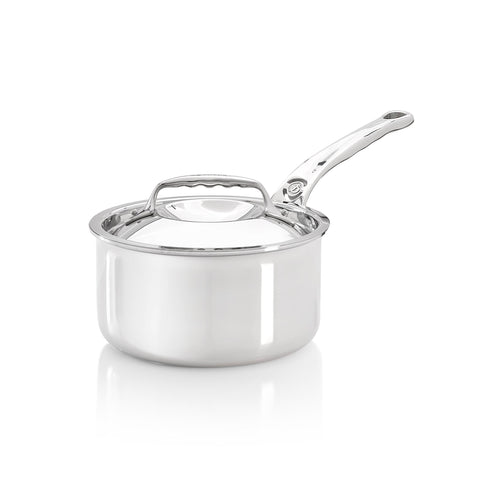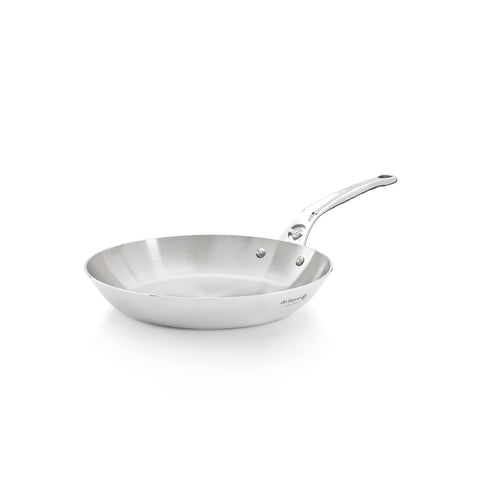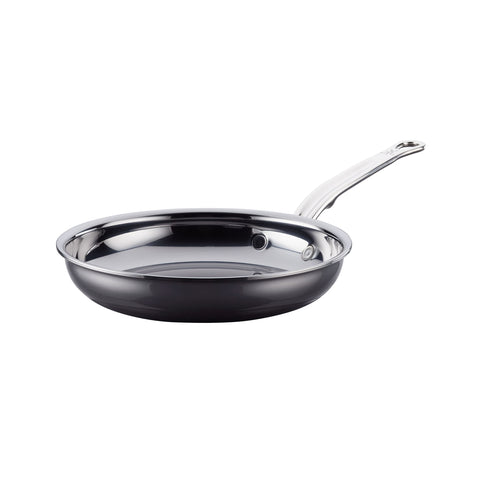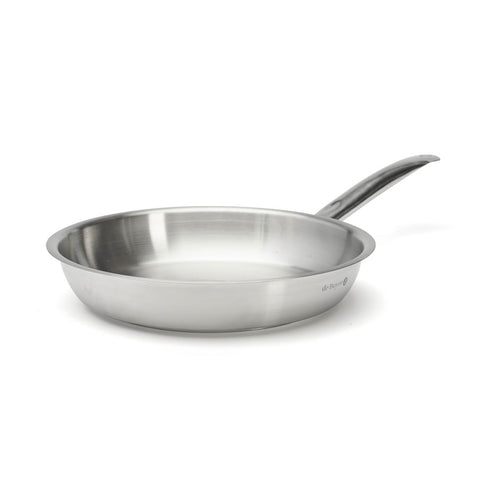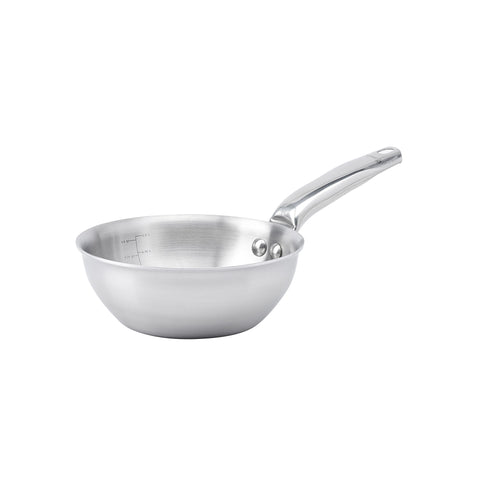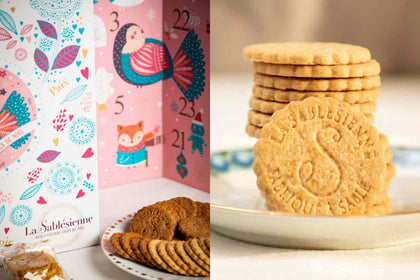Buyer’s Guide To Stainless Steel Pans
by Holly Thomson

Select the right stainless steel pan for your kitchen in our guide to stainless steel pans. Stainless steel is a fantastic choice for pans, and often seen in professional kitchens.
Additionally, frying with stainless steel frying pans can require a little practice, especially if you're more used to using non-stick. However, you can achieve an almost non-stick effect with the right techniques.
Stainless steel is durable, versatile, and built to last. If you want a pan that can handle anything from searing to deglazing, it’s a solid investment.
Jump To…
How we test stainless steel pans
What you should look for in stainless steel pots and pans?
Top stainless steel pan brands
5 Best stainless steel pans
Stainless steel cookware FAQs
What stainless steel pans do chefs use?
How do we test stainless steel pots and pans?
At Sous Chef, when we are looking for the best stainless steel pots and pans we are looking for:
-
Durability: Stainless steel is extremely hard wearing. But is the pan also made really well? A good stainless steel pan needs to be resistant to scratches, dents, and other wear and tear that can occur with other materials. This means that your stainless steel frying pan will last you a long time without needing to be replaced.
-
Heat Distribution: Stainless steel frying pans are great for evenly distributing heat and retaining it, which is essential for cooking at high heat. This will mean a good, flat base that sits on the heat source consistently. Additionally, these pans do not have a non-stick coating, allowing them to withstand high heat without damage.
-
Reactiveness: It is non-reactive, meaning it won’t leach chemicals into your food while you’re cooking. It’s one of the best non-toxic cookware you could have.
-
Ease of clean: Is the pan easy to clean? Unlike other materials such as cast iron, stainless steel won’t rust or corrode when exposed to water and detergents. This makes them easy to clean and maintain. Other elements such as handle rivets, and weight of the pan also affect how easy it is to clean.
-
Design: We assess factors such as handle shape and length, whether or not the sides are flared, does the pan have a lid? And we choose the pans with the best design elements that make them a pleasure to use day in and day out.
Which are the best stainless steel pans?
Start with the material. 18/10 stainless steel is a type of stainless steel cast with 18% chromium and 10% nickel. It is some of the very best steel composition for kitchen pans, as it resists rust and keeps its shine.
Plus, look for a stainless steel pan with a core of aluminium or copper. This combination ensures even heat distribution, essential for cooking without hot spots.
You might see stainless steel pans with 3-ply or 5-ply thickness for instance. Which refers to the layers of metal in the pan.
What you should look for in a stainless steel pan?
Choosing the best stainless steel pan depends on quality and features that improve your cooking performance. And everyone has their own preference. But here are the criteria we like to look for at Sous Chef.
- Correct composition: Look for cookware with layered construction—such as "sandwich base", triply (or tri-ply) or 5-ply/multi-ply. A common setup includes an aluminum core sandwiched between stainless steel layers, which helps spread heat evenly. Some pans have a “sandwich base” (only layered on the bottom), while full 3-ply or 5-ply pans extend the layers up the sides, offering better all-around heat control.
- Helpful features: Pouring lips, measurement lines, and curved rims make cooking and pouring easier; straight rims work well for shallow frying. These small design details can make a big difference in everyday use.
- Lyonnaise shape: Pans with high, curved sides (Lyonnaise cut) let you slide food out easily—great for delicate dishes. The shape also avoids sharp angles, which helps with stirring and flipping.
- Cool, sturdy handles: Welded or riveted handles that stay cool make cooking safer and more comfortable. They also provide a strong, secure grip, especially when moving a hot pan.
- Wide, flat bottom: A broad base gives more space to cook multiple items at once without overcrowding—ideal for pancakes or eggs. It also ensures even browning and better heat contact.
- Non-stick coating: Stainless steel pans with a non-stick layer, like the De Buyer Affinity, need little oil and are easy to clean. Food releases easily, making them perfect for flipping eggs or pancakes.
- Dishwasher safe: Most stainless steel pans are dishwasher friendly—just skip those with wooden handles or non-stick unless the label says it's okay. This makes cleanup much quicker after cooking.
Stainless Steel Pots and Pans Brands
De Buyer Stainless Steel Cookware
One of our core stainless steel ranges at Sous Chef, we admire everything about De Buyer’s French-made pots and pans. You’ll often find De Buyer in professional kitchens across the world.
De Buyer stainless steel Prim Appety pans, such as the De Buyer Prim Appety Stainless Steel Saucier, have a magnetic, heat diffusing base so they are compatible with all cooking surfaces, including induction.
Whereas, De Buyer Stainless Steel Alchimy range of pans, including the De Buyer Alchimy Saute Pan, provide even heat distribution and total control to chefs with their triple-layer design. De Buyer’s Prima Matera range combines induction-compatible copper with stainless steel, to create a beautiful pot or pan that you wont want to hide away.
Hestan Stainless Steel Cookware
Hestan’s Nanobond technology gives stainless steel a supercharge. The Nanonbond surface is made with thousands of titanium layers. It’s 400% stronger than stainless steel so it won’t scratch or stain, even with metal utensils. NanoBond pans heat quickly and evenly and remain heat-resistant up to 565°C. The pans are usable on any type of hob, with an ergonomic handle for comfortable gripping, even induction hobs are compatible.
Scanpan Stainless Steel Non-Stick Cookware
SCANPAN’s HaptIQ stainless steel pots and pans are built with five layers of stainless steel - then finished with a ‘Stratanium+’ coating, which is a fantastic quality non-stick finish. The resilient Stratanium+ coating that prevents food from sticking, reduces oil and fat needs and makes the pan ultra-durable… all while being easy to clean. Metal utensils are even handled in their stride.
Five best stainless steel pans
- Best for: Boiling, simmering, and reheating.
- Multi-layered stainless steel with an aluminium core ensures even heat distribution across the base and sides.
- Comes with a stainless steel lid, ideal for cooking rice or keeping food warm.
- Rolled lip design allows for drip-free pouring.
- Best for: Searing, browning, and frying at high temperatures.
- Constructed with multiple layers of magnetic stainless steel and an aluminium core for fast, even heating.
- Available in various sizes (20–32cm) to suit different cooking needs.
- Ideal for everyday high-temperature cooking.
- Best for: High-performance cooking with a durable, non-reactive surface.
- Features an ultra-resilient cooking surface that is scratch and stain-resistant.
- NanoBond technology makes it four times stronger than traditional stainless steel.
- Suitable for use with metal utensils and resistant to tarnishing.
- Best for: Versatile cooking tasks like frying, searing, and flambéing.
- High-quality stainless steel construction ensures durability.
- Curved edge forms a pouring lip all around for easy transfer of sauces and oils.
- Compatible with all hobs, including induction.
- Best for: Sauce reduction, sautéing vegetables, and precise cooking.
- Triple-layer design guarantees fast, even heat distribution and control.
- Conical shape facilitates easy stirring and sauce reduction.
- Suitable for all stovetops, including induction.
- Best for: Aluminium core for great heat control
- Ergonomic handle
- Durable
- Best for: Titanium surface for extreme durability and very scratch resistant
- Aluminim core for great heat control
- Rolled lip/pouring rim for easy pouring
- Best for: Good value
- Aluminium sandwich base for improved heat distribution
- Best for: Curved to easily reach into all "corners"
- Deep for bigger batch cooking & sauces
- Easy to use with a whisk
- Best for: Good size for general use
- Aluminium core for great heat control
- Ergonomic handle
- Durable
Stainless Steel Pots and Pans FAQs
Why choose stainless steel pots and pans?
Stainless steel pans are prized for their robustness and sleek appearance. Unlike other materials that degrade over time, stainless steel offers a surface resistant to rust, corrosion, and stains.
Its non-reactive nature means when cooked, it won’t impart metallic flavors to acidic foods like tomatoes or citrus, making it an ideal choice for a variety of dishes.
How to care for stainless steel pots and pans?
Proper care, such as hand washing with hot soapy water and a soft cloth, will extend the life of your stainless steel pans. If needed, using a small amount of baking soda can help remove any stubborn oil stains without scratching the surface.
It is also important to use oven gloves while handling hot stainless steel pans to ensure safety and protection from burns.
How to choose the right stainless steel pots and pans?
When selecting a stainless steel pan, consider fully clad options that offer superior heat distribution.
The size and depth of the pan should match your cooking needs—whether it's frying eggs, doing chicken, doing fish, searing large cuts of meat, or sautéing vegetables.
Other Stainless Steel Pots and Pans Questions
What should not be cooked in stainless steel pots and pans?
Highly acidic foods like tomato sauce or vinegar-based reductions can sometimes react with lower-quality stainless steel, especially if it’s not fully clad or has a damaged surface. These reactions can cause a slight metallic taste and, over time, may wear down the finish.
Is stainless steel better for pots and pans?
Stainless steel is a top choice for many cooks due to its durability, resistance to rust, and ability to handle high heat. It’s ideal for browning, searing, and deglazing, though it’s not naturally non-stick and can require a bit of technique to prevent sticking.
Do professional chefs use stainless steel pots and pans?
Yes, professional chefs commonly use stainless steel cookware in restaurant kitchens because it’s tough, versatile, and conducts heat evenly—especially when fully clad with an aluminum or copper core. It’s also easy to clean and maintain with proper care.
Are there any health risks to stainless steel pots and pans?
Stainless steel is generally considered very safe for cooking. While it may leach trace amounts of nickel or chromium when cooking highly acidic foods, the amounts are minimal and not harmful for most people unless they have specific allergies.
What stainless steel pans do chefs use?
Many professional chefs choose the Hestan Nanobond range for its unmatched performance, durability, and innovation. These pans are made with thousands of molecular titanium layers over stainless steel, making them 35% more conductive than traditional stainless steel—which means faster, more even heating. They're also incredibly resistant to scratching, staining, and tarnishing, even from acidic ingredients or metal utensils. The mirror-like finish doesn’t just look sleek—it’s also dishwasher safe and easy to clean. With their exceptional heat control, durability, and striking design, Hestan Nanobond pans are a go-to for chefs who demand the best in both professional and home kitchens.
What is a stainless steel pan good for?
- It’s strong, reliable, and built to last. Great for searing, deglazing, or tossing into the oven.
- They can handle very high heat
- When the stainless steel pan is a "sandwich"/triply/5-ply/multiply pan, they conduct quickly and evenly. Copper core pans are the premium range for conductivity and temperature control.
- Easy and simple to clean
- Robust and resilient to busy kitchen use
- Doesn’t react to food, or tarnish easily
–
Read more: Understand the best ways to cook with stainless steel, and browse all stainless steel pots and pans.

